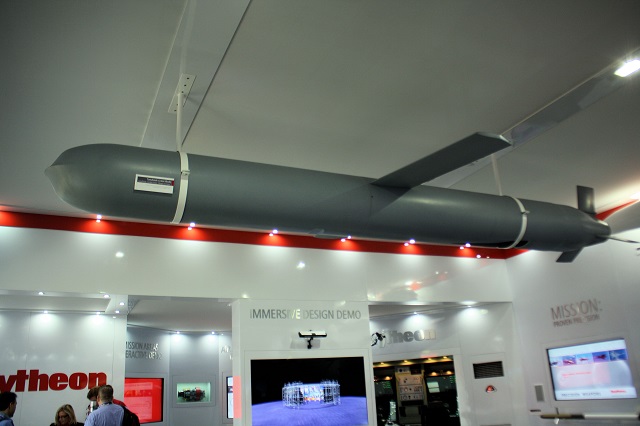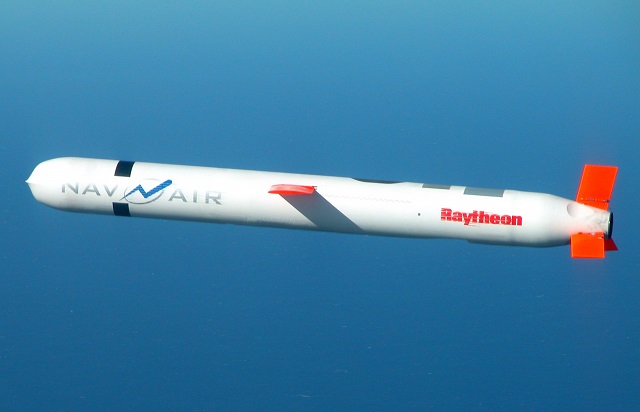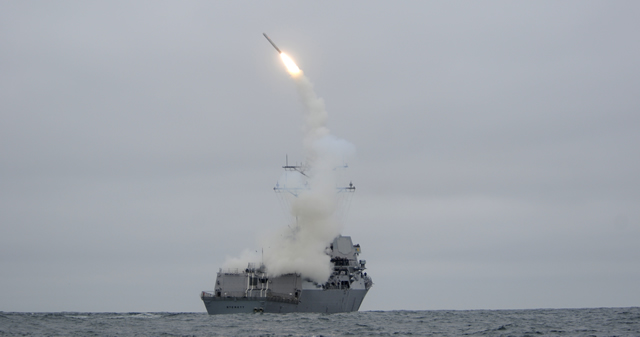|
|
|||
 Tomahawk scale model on Raytheon booth at Paris Air Show 2015. Navy Recognition picture. Tomahawk scale model on Raytheon booth at Paris Air Show 2015. Navy Recognition picture. |
|||
|
|
|||
|
If the flight takes several hours, however, the INS accumulates a navigational error. The missile gradually drifts off the course, but this comes unnoticed by the INS. Hence, the latter has to be updated by means of outside data in order to figure out its whereabouts and correct itself. The Tomahawk’s INS relies on waypoints. Waypoints are well discernible terrain features with the characteristic outlines, e.g. mountains, hills, valleys, river bends, etc. When passing waypoints, the missile turns on its electro-optical system. The INS has the master image showing how the terrain the missile is passing through should look like if the missile is on course. Comparing the standard image with the imagery provided by the optics, the INS realizes the degree of its deviation. As a rule, there are several waypoints on the route.
The Tomahawk flies 30-50 m above the ground. During its navigation correction, it climbs to 100 m for a few seconds but then descends again. The cruise missile climbs sharply once it reaches the target to ensure the best view for its electro-optical system, because the TLAM finds the target by using both its grids and video imagery. The target’s image is stored in its memory. The guidance system analyzes the video, finds the target’s outline, compares it against the memory-stored image and only then steers the weapon to the target. On average, the missile’s circular error probable (CEP) is within 10 m. The present-day Tomahawk uses satellite navigation (satnav). However, the GPS system is needed on the last leg of the flight for terminal attack. The weapon’s accuracy has grown from 10 m to 10 cm owing to its satnav capability. This is especially important when the cruise missile is employed against point targets, e.g. ICBM silos. If the Tomahawk impacts 10 m away from the silo’s cover that weighs many tons, it will not damage it. Owing to its satnav receiver, the missile will hit the middle of the cover and destroy it. However, it does not need this kind of accuracy when engaging area targets, such as airfields, bunched-up combat vehicles or fighting positions. The Tomahawk’s guidance system also relies on the GPS signal for course updates. Once updated, the INS compares its data with that of the GPS. The Tomahawk will approach its target without satnav anyway. |
|||
|
|
|||
 A Tactical "Tomahawk" Block IV cruise missile, conducts a controlled flight test over the Naval Air Systems Command (NAVAIR) western test range complex in southern California. (U.S. Navy photo) A Tactical "Tomahawk" Block IV cruise missile, conducts a controlled flight test over the Naval Air Systems Command (NAVAIR) western test range complex in southern California. (U.S. Navy photo) |
|||
|
|
|||
|
Russian media have run reports that a Russian-made Rychag-AV EW system jammed several dozen Tomahawks and made them drop to the ground. The Rychag-AV deals mostly with AD missile systems. Hence, only an utter layman can say that the system ‘jammed’ the Tomahawks.
If the missile is aimed at a point target, jamming its satnav receiver will be enough. For instance, the Zhitel EW system, which is in the Russian military’s inventory, will be just the thing. The accuracy of the Tomahawk’s guidance will diminish, rendering the weapon incapable of hitting its target. If the TLAM is employed against an area target, it does not make sense to jam the GPS signal. The missile’s warhead packs several hundred kilograms of high explosives. It will surely destroy the target even if its CEP is 10 m. Another option is to overwhelm the Tomahawk’s radalt with heavy electronic countermeasures (ECM). If the radalt fails, the missile will climb to several hundred meters at once to avoid collision with terrain features. Once it has climbed, it will expose itself to the air defenses. However, jamming the radalt is difficult. Its radar return is very weak and aimed vertically to boot. Therefore, the jammer has to cover a huge area. For this purpose, it has to enjoy very high power and be mounted tens of meters above the ground. The higher the jammer, the longer its range. However, such jammers are effective only when they are set up on the cruise missile approaches, i.e. close to where Tomahawks will fly. Otherwise, they are useless. A laser may blind the Tomahawk’s electro-optical system, making the missile unable to identify the target’s outline and forcing it to attack using the pre-loaded target coordinates alone. This will reduce its accuracy, but that will be that. The laser’s effectiveness depends heavily on weather conditions and the distance to the target to boot. For now, the most effective counter to the Tomahawk is the Pantsir (NATO reporting name: SS-22 Greyhound) anti-air gun/missile system. It has proved to be very effective against such threats in trials and on exercises. There also are advanced anti-cruise missile defense systems in trials, which are based on new physical principles, according to the Izvestia daily. © Copyright 2017 TASS. All rights reserved. This material may not be published, broadcast, rewritten or redistributed. |
|||
Tomahawk cruise missiles proved to be difficult targets for Russian electronic warfare system
- Posted On











